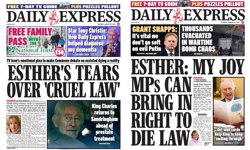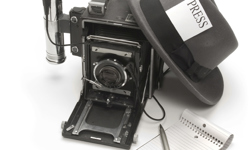I was production editor on that exciting, ground-breaking yet ultimately flawed project, wrestling nightly with unproven technology and staff learning on the job. It was my responsibility to get the paper printed on time with all the right bits in the right places.
We didn’t quite manage it. The colour, especially, drew sneers from the behemoths of Fleet Street for its amateurish reproduction, yet it did herald a new era of on-screen page make-up and use of colour.
Fast forward twenty years and now everyone’s at it. Gone are the huge mainframe computers and outdated presses trying to accommodate a level of precision they were not designed for. In come the latest generation of sophisticated pre-press systems and computer-operated presses with scarcely an inky rag in sight.
All of our national papers are now using colour, with the Independent the latest to trumpet its first full-colour issue in September. But do they know what they’re doing? What are the principles for using colour in newspapers?
Taste the colour palette
Traditionally, any discussion on the use of colour has always started by devising a colour palette. Received wisdom is that with an unlimited number of colours available, it’s important to carefully choose and organise colours that reflect your community, and the tone of your newspaper.
Global uber-designer Mario Garcia and Poynter Institute expert Pegie Stark Adam both like to hold your hand through the colourful world of, er, colour.
As Stark Adam says: "Colour is subliminal. It carries mood and meaning. A publication should reflect its philosophy and should reflect the environment in which the readers or viewers live and work in. The colours used in a publication will influence how readers view and experience a publication."
Another Poynter Institute guru, Anne Van Wagener, says there’s no big mystery to colour. "It’s a learned skill like any other. Once you know the basics you can develop your sensitivity to it, and notice how colour is used in the world." So what are those basics?
What the research says
Garcia conducted one of the few studies to see how readers perceive colour on news pages. The results showed that colour is a powerful tool attracting the reader into the page and helping the eye travel from place to place. In addition, readers said they liked colour and they believed that colour gave them more information than the less colourful pages.
Using the rather fearsome looking Eye-Trac technology, where a gadget is wired up to the reader to follow where they are looking and for how long, the research came up with two main conclusions that are still followed by designers today:
* Entry points and dominant images. Readers entered all pages through the dominant element whether it was in colour or not and whether it was a photo, illustration or large type.
* Navigation. A dominant image in colour on a right-hand page is a strong contender for the reader’s initial attention, especially if the dominant picture on the left-hand page is in black and white. If both images are similar in size the reader looks at both and bounces back and forth. One image should dominate on one of the pages, not on both.
But American designer Alan Jacobson has some harsh words for the colour palette brigade. "Sorry, but this preoccupation with colour palettes is just a bunch of horse hockey. The New York Times, the Wall Street Journal and USA Today use the same colour palette EVERYWHERE despite regional and cultural differences. They don’t tailor their colour palettes for every market they serve, so why should you? Are your readers more discriminating then theirs? I doubt it."
So, if we ditch the traditional palette idea, what becomes of the discipline and structure designers keep telling us we need. Jacobson knows: "Bottom line? As long as your paper doesn’t look like a Hawaiian shirt (unless, of course, you’re in Hawaii) it’s probably just fine. Instead of wasting time making adjustments to colours that no reader will ever notice, spend that time on something that does make a difference – like making the paper easier to read and easier to use."
Where are we now?
Poynter’s Stark Adam acknowledges that newspaper colour is much better than it has ever been. "Production and printing presses have improved so that we can hold very light screens and very subtle colour combinations that include more than two colours. People using colours have studied the craft and have developed colour palettes and colour uses that are more sophisticated and multi-dimensional than ever before. No more ‘comic book’ colours!"
"Colour is information and NOT decoration. You may like certain colours but if they do not reflect who you are and what you are about or where you are publishing, colour will give the wrong information to the reader. Every colour means something and carries with it physical and physiological properties that affect people subliminally. Be careful with colour because it is one of the most powerful tools in your designer toolbox."
Now, there’s colour everywhere in the paper. Not just colour pictures, but graphics, illustrations and headlines. And, regardless how hard the editorial designers try to bring some order out of the colourful chaos, there’s no accounting for the ads whether it’s npower’s red, DHL’s yellow or hmv’s purple.
| Alan’s verdict on how some of our national newspapers are handling colour: The Guardian Lots of big pages with lots of type and almost no colour, save for their house tints of sludgy brown and purple. Often generous use of pictures especially in the over-indulgent double page ‘Eyewitness’ spread. A few, small colourised graphics but it’s largely left to the ads to add the colour. Verdict: Drab. The Daily Telegraph Still revelling in its broadsheet status, using decent sized images. Neat colourised illustrations and colour-coded page tops for the different sections. Not too much of a slave to the palette although the red / grey combination does look a bit too much like building society promotional material. Verdict: Big is, er, best. The Independent Newest kid on the full-colour block. Still evidence of some experimentation, and it’s rather surprising they’ve plumped for red as their main house colour for furniture fading into purple (puce?) for Opinion. Strong covers using yellow and orange with plenty to engage the casual reader. Verdict: Work in progress. Daily Mail No colourful nonsense here. Ok, so pictures are in colour but no coloured type, graphics, tips or tricks. Obvious areas for improvements – like TV listings – are left in glorious mono and even sport has a distinctly lack-lustre grey feel. Verdict: Monoculture. Daily Mirror Here comes the march of the yellow! Yes, yellow does make you look (think high visibility jackets) but too much can appear like the aftermath of a fight at the custard factory. Lively, in yer face and colourful, but one to have the purists spluttering into their palettes. Verdict: Yellow fever. Daily Star What’s bright yellow and red all over? Yes, of course the Daily Star. Not yet full colour throughout, it works hard with limited colour options, although the many remaining mono pages look drab against the opposition. Verdict: Trying hard. The Sun Colourful without descending into comic-book farce. Displays all the Sun’s traditional verve and imagination, especially using colour in type to good effect. Neat use of colour graphics on TV listing shows what can be done. Verdict: Stylish – in its own way. Daily Express Much of their colour page allowance is given over to those pesky ads, but the space they do get is used with commitment and verve. Page 3, and its corresponding pair inside sport, both have bold colour pictures but there is precious little else to talk about. Verdict: Bold effort. The Observer Forget all that sparing use of colour nonsense practised by stablemate the Guardian, just throw the rainbow at it! Just on the front there’s green, red, blue, purple and of course yellow – and who let that yellow Ryanair ad through! Colour-coded section tops and generous pictures in the lifestyle section. Verdict: Rainbow – Zippy or Bungle? Sunday Mirror A strange addiction to green, purple and a sort of parma violet makes this a difficult read. There doesn’t appear to be any kind of colour plan and it’s only in the sports section that things take off with any kind of élan. Verdict: Head straight to sport. Sunday Times Beautiful colours for all the sections, intelligently reproduced within the pages, give this title a feeling of wholeness that is sadly lacking in other products. Giving this huge newspaper a sense of identity is no mean feat and the clever use of colour goes a long way to putting the stamp on it. Verdict: The one to beat. |










